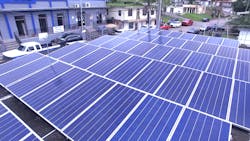Microgrids Bring Wealth and Health to Puerto Ricans Without Power for More than a Year
In Cordillera Central, a mountainous region of Puerto Rico, two rural microgrids deployed by the island’s first electric cooperative are yielding an unexpected advantage: Wealthy Tesla and other electric vehicle (EV) owners journey to the small low-income towns there to charge their cars, then stay and shop.
This makes townspeople feel connected to the 21st century. They didn’t always feel that way because for more than a year following Hurricanes Irma and Maria, the 91,300 people in Adjuntas, Jayuya, Lares and Utuado, an area with a 60% poverty rate, were without power.
Attracting wealthy car owners isn’t the only advantage of the microgrids, the first community- based microgrids in Puerto Rico. The microgrids, which operated through Hurricane Fiona, not only provide lower energy costs and energy resilience but also help protect the health of local citizens.
The cooperative’s contract with microgrid-fed businesses stipulates that anyone in the community who needs to use a medical device during outages has access to the microgrid, said C.P. Smith, executive director of the Cooperativa Hidroelectrica de la Montana, which owns the microgrids and supplies power to eight businesses, two residents and two EV chargers.
For example, during one power outage, a woman gave herself lung therapy at an ice cream shop electrified by a microgrid. And a restaurant provided refrigeration — powered by a microgrid — to preserve a child’s medicine.
30 more microgrids coming
Next, the cooperative aims to deploy 30 solar microgrids in the area, each about 100 kW. The cooperative recently received $250,000 from the federal Department of Energy (DOE) through its Inclusive Energy Innovation Prize, which aims to promote equitable clean energy. Through the prize, the DOE invests in community-led innovation in regions historically underserved by federal funding.
This project is expected to allow businesses to lower energy costs, reduce pollution, reap more revenues by staying open longer and avoid expensive power outages. In addition, it’s expected to help prevent younger people from leaving the region, said Smith.
The cooperative will use the DOE funding to create load profiles of five types of businesses in the area: pharmacies, laboratories, grocery stores, bakeries and mini markets.
Smith has hypothesized that specific businesses — bakeries, for example — have similar load profiles. Characterizing those profiles will help shorten the microgrid development time by helping project participants understand how much energy is needed and when.
Assuming all requested federal and state funding comes through, the cooperative plans to install photovoltaics (PV) on the roofs of local business, community centers and some residences. The cooperative has already won the $250,000 in DOE “prize” money and has applied for additional state and federal government funding.
Each system will include battery storage and a controller. The cooperative will own the systems and lease them to cooperative members with a fixed rate that’s more cost-effective and predictable than existing utility rates. Current utility rates can be as high as 30 cents/kWh, said Smith.
The project cost is about $17.5 million for every 5 MW block of PV.
Right now, businesses must make difficult choices during power outages. They must decide whether to fire up expensive and polluting diesel generators — after sourcing the fuel, which isn’t always available — or shut down their businesses. “These are tough decisions because the businesses operate on 5% to 10% profit margins,” said Smith.
But with the microgrid power, the businesses can expand their hours and tend to their clients without worrying about losing power.
Microgrids will create virtual power plants
The centralized grid will also reap benefits. The cooperative plans to network the microgrids together via the internet, control them remotely and create Puerto Rico’s first virtual power plant (VPP), said Smith. The VPP could help cut the amount of additional new generation that Puerto Rico needs for peak demand events, instead of using or building new diesel peaker plants. And the VPP could help stabilize a section of the grid on sunny days when the microgrids produce extra solar.
New policies in Puerto Rico paved the way for this type of project, said Smith. In January and August 2017, the governor at the time, Ricardo Rosselló, created amendments to the Public-Private Partnership program that allow for unsolicited proposals, predevelopment agreements and facilitation of the approval procedures for projects. Advancing the program is seen as a way to rebuild infrastructure and promote economic development.
Puerto Rico also set a goal of achieving 100% renewable energy by 2050 and required the Puerto Rico Electric Power Authority to ask the Bureau of Energy to approve rate change proposals, said Smith.
Other remote microgrids have helped rural Puerto Rico. For example, even before Hurricane Maria hit Puerto Rico, the community of La Montana — located in the mountains within the town of Yauco — didn’t have grid power because of its remote location and rough terrain. And after an earthquake hit the region, the local residents lost their well so were left without power and water. Residents had to drive a water truck down the mountain to fill up water tanks. The truck then delivered water to each household.
Beginning in April 2021, the organization Por los Nuestros — a nonprofit that focuses on renewable energy and health — drilled a new well in the community and installed a solar microgrid to pump water from the well to the households. The microgrid was deployed in February 2022.
Irony and appreciation in Cordillera
For residents of the Cordillera Central area, the two microgrids bring a degree of irony. The Tesla drivers who charge at the microgrid likely paid more for their EVs than all the area businesses make in a year, said Smith. But no one is complaining.
“They love that people are coming to plug in EVs and bring a different clientele for their businesses,” he said.
Track news about today’s energy revolution. Subscribe to the free Microgrid Knowledge Newsletter.








